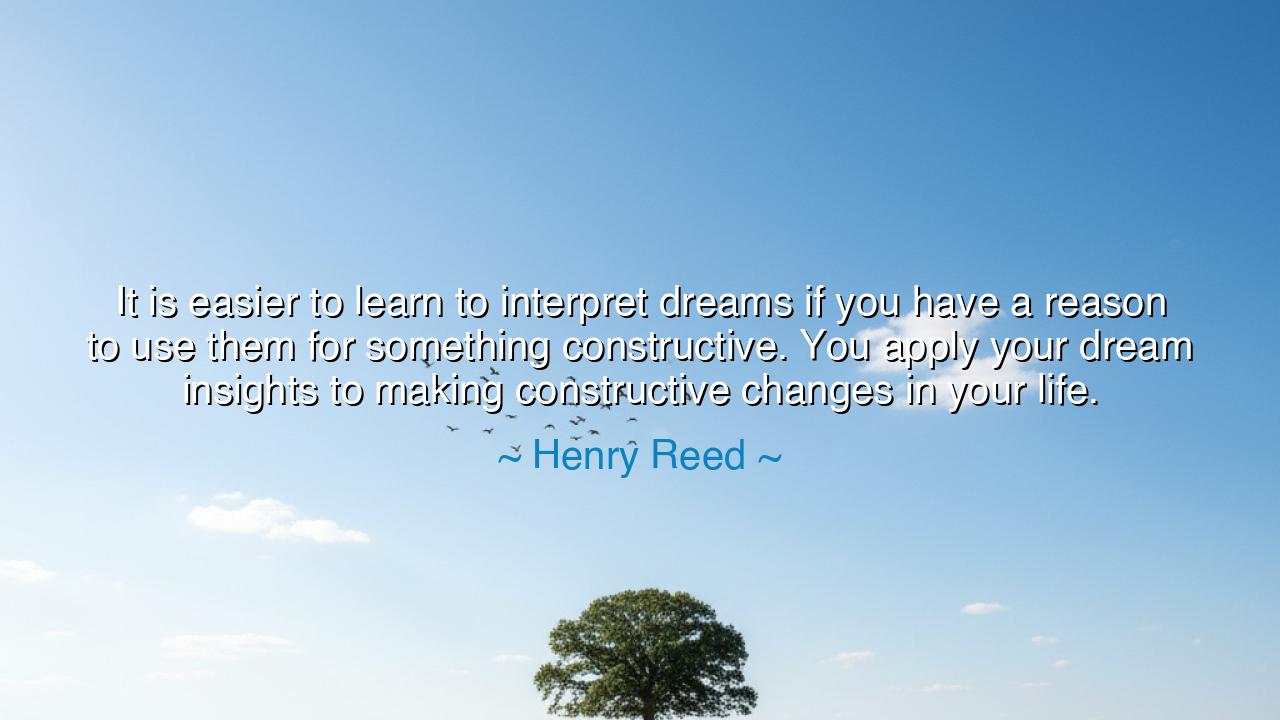
It is easier to learn to interpret dreams if you have a reason to
It is easier to learn to interpret dreams if you have a reason to use them for something constructive. You apply your dream insights to making constructive changes in your life.






Listen, children of reflection, and heed the words of Henry Reed, a thinker attuned to the subtle whispers of the mind: “It is easier to learn to interpret dreams if you have a reason to use them for something constructive. You apply your dream insights to making constructive changes in your life.” In this wisdom lies a recognition of the hidden currents that flow beneath the conscious mind, and a guide for how these currents may be harnessed to shape destiny, rather than drift unheeded into the ether.
Since the dawn of human understanding, dreams have been revered as messengers from realms unseen. The ancients, from the scholars of Egypt to the philosophers of Greece, regarded dreams as windows into the soul and the divine. Yet, as Reed observes, knowledge of these visions is not enough; the mind must be motivated to act. A dream without purpose is like a seed cast upon barren soil—it may exist, but it bears no fruit. Only when dreams are applied to the work of life, to constructive change, do they manifest their full power.
Consider the tale of Joseph in the land of Egypt, whose dreams were filled with visions of sheaves and stars bowing before him. Alone and imprisoned, he did not dismiss these visions; instead, he interpreted them with care and foresight. His understanding of the dreams allowed him to advise the Pharaoh, preparing Egypt for seven years of famine. Here, the dreams became instruments of practical wisdom, guiding action, shaping the course of history, and transforming insight into tangible benefit.
Even in the quieter currents of life, this truth endures. When one reflects upon the symbols that rise in the night, when images stir the heart or provoke contemplation, one may discern patterns and truths that escape the waking mind. Dream insights can illuminate fears to be faced, passions to be pursued, and decisions to be reconsidered. They offer a mirror of the subconscious, revealing what the conscious self may overlook. Yet the value lies not merely in understanding the dream, but in translating that understanding into constructive action.
History is rich with those who have applied nocturnal visions to life’s endeavors. Consider Elias Howe, the inventor of the sewing machine, who dreamt of small figures with spears pointing toward them—an image that inspired the idea for the machine’s needle. His dream insights, once interpreted and applied, yielded a creation that transformed industry and human labor. This exemplifies Reed’s teaching: the power of dreams is magnified when purpose and action accompany perception.
To pursue this wisdom, one must cultivate attention and reflection. Keep a record of dreams, seek their meanings, and ask: how might these visions guide a constructive change in my life? Do they reveal a hidden fear to confront, a talent to nurture, or a path to follow? By linking dream interpretation with intention, the mind becomes an ally rather than a passive observer, and the insights of the night are carried into the light of day, shaping choices and destiny.
The teaching extends beyond individual growth. Communities and societies may heed the lessons of collective imagination, interpreting shared dreams and symbols to navigate cultural, political, and spiritual challenges. The act of applying dream insights to the world fosters creativity, understanding, and progress. Constructive change, whether personal or collective, arises when the unseen is acknowledged and brought into deliberate action.
Finally, remember that dreams are not idle fantasies, nor mere entertainment of the mind. As Henry Reed guides us, they are tools, mirrors, and guides: to interpret them without purpose is to squander their gift; to interpret and act upon them is to harness a power as old as human consciousness itself. Guard your reflections, honor your visions, and let the wisdom of the night illuminate the work of the day. In this union of insight and action, the soul finds its most enduring strength.
If you wish, I can also craft a poetic, meditative version of this explanation for audio narration, emphasizing rhythm and imagery to make Reed’s lesson even more vivid. Do you want me to do that?






AAdministratorAdministrator
Welcome, honored guests. Please leave a comment, we will respond soon